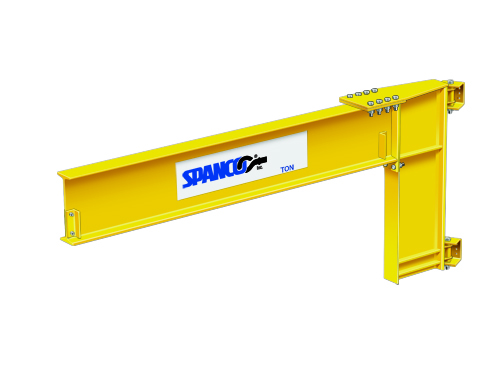
Material Handling Wall-Mounted Jib Cranes
Sep 22, 2014
Wall-mounted jib cranes are a great material handling solution for busy factory floors and facilities with multiple obstructions overhead. That’s because wall-mounted jibs require no floor space and no special foundations, and they quickly fold out of the way of larger overhead cranes.
Wall-mounted jibs provide crane coverage of a semi-circular area, which is perfect for individual workstations or to supplement an existing bridge crane. With standard spans up to 30 feet and capacities up to 5 tons, these ergonomic systems are both economical and heavy duty.
Many manufacturers offer two different types of wall-mounted jibs: a cantilever design and a tie-rod supported design. Both designs provide 200-degree rotation and can be mounted to a structurally adequate wall or column support. The difference between the two is in how they are mounted and the unique advantages of each.
Full Cantilever Design
A wall-mounted cantilever jib crane consists of a horizontal boom attached to a vertical mast, which is mounted with brackets. Because the cantilever design utilizes a partial mast and full boom, these systems provide maximum clearance in factories with multiple overhead obstructions. A wall-mounted cantilever jib crane can be installed in very tight locations and as close to the ceiling as possible for the best use of space.
Furthermore, wall-mounted cantilever jib cranes transmit less direct force to building columns and support structures than tie-rod supported jibs. That’s because the brackets, which are used to mount the mast to the wall or column, are further apart than on a tie-rod supported jib. For instance, a 1/2-ton capacity wall-mounted cantilever jib crane with an 8-foot span includes brackets that are (roughly) four feet apart. In comparison, the tie-rod supported system with the same capacity and span includes brackets that are (roughly) three feet apart. The cantilever design with 4-foot bracket centers imposes a thrust/pull force of approximately 2,600 pounds; whereas the tie-rod supported system with 3-foot bracket centers imposes much more force—approximately 3,710 pounds.
Tie-Rod Supported Design
The tie-rod supported design is one of the most economical wall-mounted jib cranes available. Although the cantilever design offers more clearance under and above the boom, the tie-rod design provides the greatest clear span. The whole system consists of a standard I-beam suspended from a vertical support structure with a single tie-rod and brackets. The tie-rod is suspended overhead, which means it uses more room above the boom, but it also allows the trolley to travel over a longer span because there’s no mast to obstruct movement. The single tie-rod is also beneficial because it eliminates problems with off-center loading. This system is the perfect solution for busy factories with multiple floor obstructions and plenty of overhead room. Compared to other jibs, the tie-rod supported system is an inexpensive solution for large facilities looking to install multiple jibs throughout the building without obstructing operations below the boom.
Whether you need a lot of extra clearance—under or above the boom—or additional travel span for your trolley to move the full length of the boom, wall-mounted jib cranes are an economical solution for moving materials within an individual workstation or to supplement larger overhead crane systems like monorails or bridge cranes.
Categories
Share this post
Contact us
Looking for the perfect fall protection equipment? Let us help!

